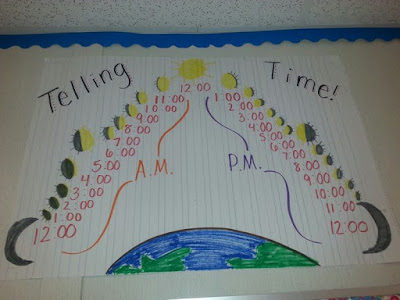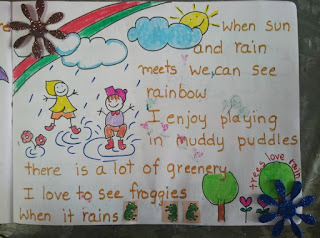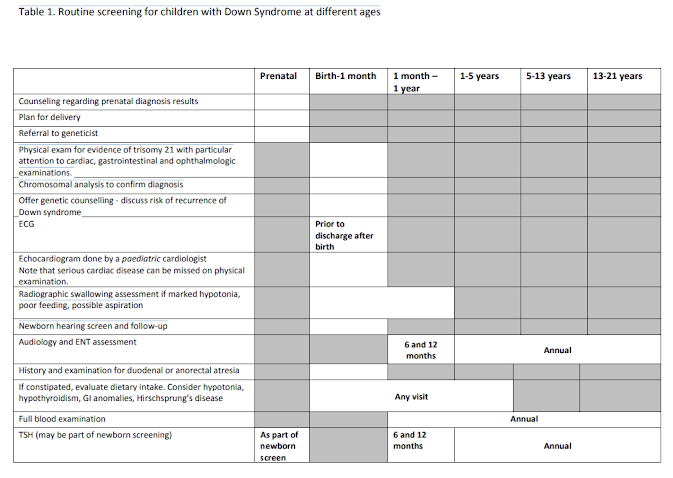CONCEPT OF 'TIME' AND A CHILD WITH DS
CONCEPT OF TIME AND A CHILD
WITH DS
What is the right age to introduce 'TIME CONCEPT'?
How to make them aware of 'TIME ZONE'?
How to teach them about minutes/hours/days/ weeks/ months/ year?
Many parents must have experienced that our children remember 'days
of the week', 'months of the year' & 'seasons of the year' very easily. When
asked, they answer promptly. As we all know their receptive vocabulary is very
good and they remember things without understanding the meaning of it. When asked
about 'days of week ',' months of year' or 'seasons of the year' they might not
be aware of the meaning. An hour is a unit of day, morning/afternoon/ evening/night
are time zones of day, a day is a unit of week, a week is a unit of month, a
month is a unit of year & seasons are time zones of year.
If on one fine
day you sit with your child & start explaining him about all these
fundamental things from a book it is not possible for a child to understand
even a bit of it.
Then 'How to go for it?' & even more important is 'When to go
for it?'
Palak could understand
'TIME' meaningfully since beginning. She must be 2 months when I started talking
to her everything in respect of time. 'It is 6:30 in the morning; mummy is late
by 30 minutes today. I should have woke up at 6. Now I'll have to make haste.
It will take an hour to get ready and make both of you ready...etc.' My working
hours were 10:00 am to 1:00pm & 4:00pm to 7:00pm. Daily I made it for sure
to mention the time & zone (morning/afternoon/evening/night) of day while
going out & coming back home. Mentioning the name of day in the morning
& again while going to bed at night gave her an idea that one day ended and
the next morning will start with new day with different name. We used to
narrate the routine of the day daily during lunch & dinner time. What we
did on that day, the previous day & what were the planning for next day. We
used to talk with her regarding the food she took the previous night or same
day morning & what she would prefer the next day.
We repeatedly mentioned
the day name & time zone. By the
time she was 2 years she had very clear ideas about days of the week & time
zones of a day.
It was very essential to make her understand when Monday
becomes Tuesday. We started celebrating Birthdays in the midnight at 12. During
those days there were clocks & wrist watches available in which if you move
the hands for two complete circles (that
makes 24 hours) manually, the day & date changed to next level. We used
them extensively.
This helped her to understand AM & PM as well.
We used the single day & date calendar. Palak had to tear
the previous day page each morning.
After that we added
mentioning the name of the month as well in the morning i.e. it's the month of
February & today is Monday. She was able to tell all 12 months of the year
when she was 34-36 months, but, was not clear about the meaning of month. We
introduced monthly calendar that displayed one month at a time.
She had to change
the page on 1st of each month.
Palak knew seasons grossly by dividing 12 months
into 3 equal parts. Oct-Jan Winter, Feb-May Summer, June-Sep Monsoon.
Palak could
get the concept of seasons very easily & at an early age because she stayed
with my parents for four years and during Summer Ahmedabad being very hot she
used to stay with us. During Diwali, it being a festive time, again she stayed
with us. The start of Summer & Winter was very clear in her mind.
We made charts for each season. The contents were cloths to wear, things to do, food to eat & the weather.
(One of the mother sharing a National group with me has created excellent worksheets. I am sharing those worksheets here. She is Ms. Deepti Rohan Rastogi & I love her creativity.We made similar with cuttings from magazines/news papers etc.)
By the time Palak turned 6, she had the clarity of day, date, month, time zones of day & seasons. We had one permanent calendar with months,dates and days mentioned. There were three plastic movable circles one for month, second for date & third for day. Palak used to shift the circle daily for date & day and monthly for month.
There are lots of ideas to make your own calendar available on internet.
(you may remove 'weather' from the above list)
She was able to tell the number of days in a particular month by counting on knuckles at 8, but was not aware of leap year so for her, the month of February always had 28 days till she was in 4th or 5th STD.
As I mentioned in my previous blogs Palak had a habit of following
the time table since a very young age. As she grew she was encouraged to
prepare her daily & weekly timetable on her own. That helped her to
understand 'TIME CONCEPT' thoroughly.
Palak had a clear idea about the function of a clock at 4/5. She was
very regularly doing various activities with beads. She was enjoying threading
beads. We decided to use beads to make her read the clock. We had already
started teaching her tables with the use of beads.
(10 bunch of 2-2 beads, each bunch of same coloured bead but
different coloured from the next bunch. Thread it & count it. 2 + 2 = 4, 4 +
2=6.....so two times 2 is 4, three times 2 are 6.....likewise for 3, 4 & 5)
At 6 years of age, she learned tables till 5*10=50. Pictures, photos, diagrams were the major part of her learning material. We had a big pin-up board with different charts & various visuals pinned up. The chart for tables was a constant content of that board. She was very quick in
answering tables.
Palak was ready with the basic knowledge, we just needed to combine all her learning till that day. We started with reading the clock. We explained her about long hand & short hand.
The distance between two numbers for a long hand to travel is 5 minutes & for short hand is an hour.
We used the hour glass simultaneously to emphasize
the concept.
Palak was ready with the basic knowledge, we just needed to combine all her learning till that day. We started with reading the clock. We explained her about long hand & short hand.
The distance between two numbers for a long hand to travel is 5 minutes & for short hand is an hour.
We helped her to
understand the meaning of half an hour and quarter using a toy clock & a
clock made on a paper dish.
In present days lot of printable material is available online for practice but we
made them on our own in those times.
At 8 years of age, Palak could read clock if the long hand was exactly at 1/2/3...10 by multiplying the number with 5.
Within a year she could read clock unconditionally.
At 8 years of age, Palak could read clock if the long hand was exactly at 1/2/3...10 by multiplying the number with 5.
Within a year she could read clock unconditionally.
The concept of year was explained with the help of Birthdays, major
festivals, holiday trips, standard of study etc.
We made it a rule for both our children to narrate the happenings & their experiences in detail after the vacation/trip got over. Again while planning the next trip we used to discuss the previous trip mentioning the year/month & dates. Once Palak was able to describe her thoughts in writing, we made her write about the trip & she did it every time with full details of day & date.
We made it a rule for both our children to narrate the happenings & their experiences in detail after the vacation/trip got over. Again while planning the next trip we used to discuss the previous trip mentioning the year/month & dates. Once Palak was able to describe her thoughts in writing, we made her write about the trip & she did it every time with full details of day & date.
Various things we have made for our school children to make the
'TIME CONCEPT' clear. Similar things are available easily online. I have posted a
few & here are some more.....
(You can make your own dice as shown & play)
Few activities to emphasize upon seasons:





























































Comments
Post a Comment